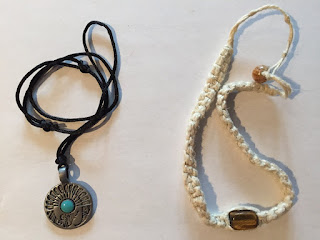I just need to get this written down while it's still relatively fresh in my mind...too long to tweet about in any kind of detail, so this is "gonna" be a little messy.
First Class:
We were going through our first
visual pattern in my grade 9 applied math class (MFM1P1)
a la Michael Fenton, with a couple variations...I keep the column of 5, and add columns of 3 each time which I find helpful when it comes to developing the equation intuitively.
eg: Stage #10 looks like this
After they draw stage 10, I ask them how many circles they used (32) and how they calculated their answer. If necessary I ask for a few different ways to come up with 32, until someone says "3 times 10 plus 2," which is what I'm pulling for.
Oh yeah, this post is supposed to be about high fives...so anyways, while we are making our table of values, J asks, "What about high fives?" Alright, I bite. I ask him, "What do you mean 'what about high fives'?" and he responds by saying that if there's two people, they can only high five each other, but then if there's 3 people, they can have 3 high fives. At this point I realize that, seemingly out of nowhere, he's asking about the handshake problem. (I love the curiosity and initiative, so I decide to run with it) Teaching Tangent Time: I say let's pause from our visual pattern, and check this out. I have J and another student stand up and high five each other, while I start recording the results in a table on the whiteboard. I ask another student to join, and for the 3 of them to high five each other....this continues until we have 6 students all high fiving each other, and the following table on the board.

I tell J "you have enough info to get started, try to figure it out for our next class," and we return back to our visual pattern as a whole class. BTW our grade 9s are one-to-one with Chromebooks this year, and I've got a fever for more Desmos :)
Next Class:
The first thing I ask J is if he's figured out his high five problem, but he says no. I anticipated that this might happen, so I had thought up a way for us to model this in class...walk off home runs!
I start with 1 student getting zero high fives in the corner of the class, and when the next student joins him in the corner, they get to high five. Then we add another student to the pair in the corner, and another, and another. As we add each student they start over trying to high five each other, and I record the results in a table on the board (like yesterday). By the time we have 6 students in the corner, someone complains that there's not enough room and we should spread out along the wall. Yes, yes we should!
Once the 6 are lined up I ask, "It took 15 high fives for all of you to high five each other, let's start there and count on as the next student joins and high fives each of you." Off we went, adding one student at a time to the group, counting on as they high fived everyone that was already lined up. I tried to hype it up like they are your teammates lined up at home plate after you just hit a walk home run in the World Series. The EA in our class is the best! She even stepped in as the DH for a student. Here's what it looked like:
Were they as excited as me? Nope.
Did it run perfectly? No way.
Was it an active way to model the "handshake problem"? You bet.
But most importantly, students discovered how the non-linear pattern grew. Maybe next class we will develop the equation, or try some counting circles.





















